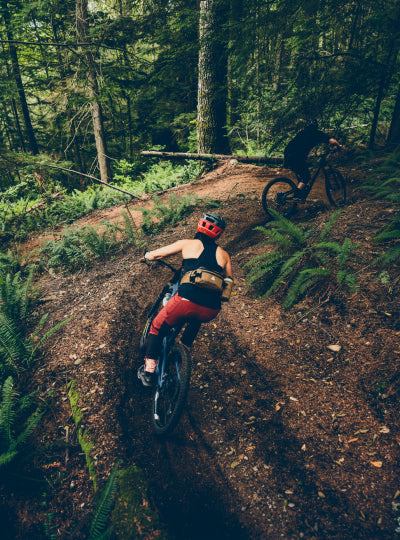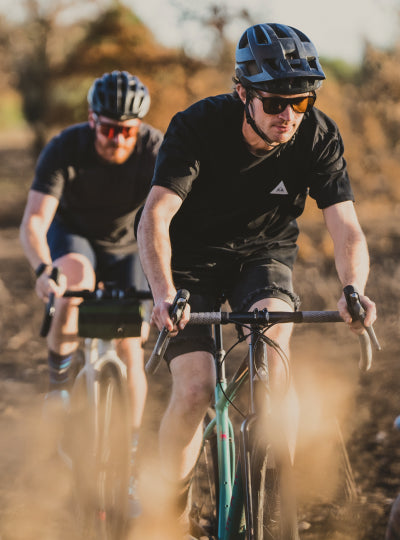Manuals can be an integral part of cycling, especially mountain biking. They’re a fun trick to show off to your friends, but just like wheelies, there is skill-based value in knowing how to manual that goes beyond looking cool. Manuals can help you carry momentum between rollers, get up and over obstacles, or even improve your ability to drop off of ledges, logs, and rocks. Follow along with PNW Squad member Kyle Warner as he teaches us how to manual. We’ve added in our tips and tricks below to help you get started.
Step 1: Getting Your Front Wheel Off the Ground
- Ride your bike in a standing position with the dropper post all the way compressed.
- Press the heel of your front foot slightly towards the ground.
- Dropping your front heel shifts your weight towards the back of the bike.
- Compress your knees to get into a “ready” position.
- Press your weight into your heels and extend your legs so your butt is pushed towards the rear of your bike.
- Simultaneously pull backwards on your handlebars and straighten your arms only allowing for a slight bend at the elbow.
Tips
- Try holding a manual between two markers on the ground like cones or the lines of a parking lot.
- Use a bike stand or manual trainer to help dial in your body positioning.
- Keep your crank arms parallel to the ground
- Unlike doing a wheelie, speed is your friend. Try to find a slight downhill slope to learn your manuals on.
Try to Avoid
- Not adjusting your weight to keep your front wheel off the ground.
- If you're picking up your front wheel only to have it immediately crash back to the ground, try shifting your weight further backwards.
- Be aware that the further you shift your weight backwards, the more likely you are to loop out.
- Using only your arms to get the front wheel off the ground.
- Getting your front wheel off the ground demands the use of your entire body. Pull with your arms, push into your pedals with your legs, and shift your weight backwards to the rear of the bike.
Step 2: Holding Your Manual
- With the front wheel off the ground, center your mass around your bike’s rear axle.
- If your butt is not behind your rear axle, you are not distributing your weight equally.
- Keep your eyes locked on something in the distance and don’t tuck your chin to your chest. This will help you shift your weight backwards.
Tips
- Try starting your manual with your eyes already pointing into the distance. When doing this we noticed an immediate improvement.
- If you’re looking at the front wheel when you start your manual it is incredibly difficult to move your eyes anywhere else because you begin to focus on maintaining balance as soon as your wheel leaves the ground.
- If you feel like your front wheel is too high off the ground, try squatting down further to get closer to the rear tire, then extend your legs to push your weight further backwards.
- Keep a finger on your rear brake in case you feel like you’re looping out.
- Modulating your brake will drop your front wheel towards the ground.
- If you’re able to hold your manual for the length of your goal, extend your goal and try again!
Try to Avoid
- Locking your knees
- Keeping your legs straight will slow your reaction time and will keep you from dropping your butt towards the rear tire.
Step 3: Accounting for Changes in Front Wheel Height
- If your front wheel begins to fall back towards the ground:
- Drop your heels further towards the ground.
- Lower your butt closer to your rear tire.
- Push with your legs to move your weight further backwards.
- If your front wheel starts to get too high:
- Modulate/feather your rear brake.
- Roll your feet slightly forward to shift your knees towards your top tube.
- Bend your knees and act as if you are trying to bring your butt closer to your heels, shifting your weight forward.
Tips
- We’re repeating this because it’s important: keep your eyes locked on something that is at eye level and in the distance. Do not look at your front wheel.
- Use your calves to make small adjustments in both body and bike positioning.
Try to Avoid
- Standing up to soon.
- Our natural reaction to feeling like our manual is failing is to protect ourselves and stand up. By standing up we guarantee that the manual is over. Try to correct your mistakes or the bike’s position before ending the manual.
Step 4: Practice, Practice, Practice
Just like in How to Wheelie with Martha Gill, It's important to understand that learning to manual takes time. We have actually struggled with learning to manual much more than we’ve struggled to learn how to wheelie. Losing the contact point of the seat really makes things difficult. However, if you continue to learn, set goals, and practice, we believe that you’ll be manualing in no time. Best of luck!
PNW Learns to Manual (Well, Sort Of)
As it turns out, learning to manual is really difficult so we don't quite have them down yet. However, using Kyle's instruction we were able to see near immediate improvement and quadrupled the length of our manuals within the span of a few days. If we can improve our manuals, so can you.
If you have questions regarding the article, or any of our products, please contact us at info@pnwcomponents.com.






